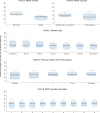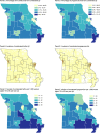Estimating the incidence of unintended births and pregnancies at the sub-state level to inform program design
- PMID: 33057337
- PMCID: PMC7561158
- DOI: 10.1371/journal.pone.0240407
Estimating the incidence of unintended births and pregnancies at the sub-state level to inform program design
Abstract
Objectives: Unintended (mistimed or unwanted) pregnancies occur frequently in the United States and have negative effects. When designing prevention programs and intervention strategies for the provision of comprehensive birth control methods, it is necessary to identify (1) populations at high risk of unintended pregnancy, and (2) geographic areas with a concentration of need.
Methods: To estimate the proportion and incidence of unintended births and pregnancies for regions in Missouri, two machine-learning prediction models were developed using data from the National Survey of Family Growth and the Missouri Pregnancy Risk Assessment Monitoring System. Each model was applied to Missouri birth certificate data from 2014 to 2016 to estimate the number of unintended births and pregnancies across regions in Missouri. Population sizes from the American Community Survey were incorporated to estimate the incidence of unintended births and pregnancies.
Results: About 24,500 (34.0%) of the live births in Missouri each year were estimated to have resulted from unintended pregnancies: about 25 per 1,000 women (ages 15 to 45) annually. Further, 40,000 pregnancies (39.7%) were unintended each year: about 41 per 1,000 women annually. Unintended pregnancy was concentrated in Missouri's largest urban areas, and annual incidence varied substantially across regions.
Conclusions: Our proposed methodology was feasible to implement. Random forest modeling identified factors in the data that best predicted unintended birth and pregnancy and outperformed other approaches. Maternal age, marital status, health insurance status, parity, and month that prenatal care began predict unintended pregnancy among women with a recent live birth. Using this approach to estimate the rates of unintended births and pregnancies across regions within Missouri revealed substantial within-state variation in the proportion and incidence of unintended pregnancy. States and other agencies could use this study's results or methods to better target interventions to reduce unintended pregnancy or address other public health needs.
Conflict of interest statement
Mathematica, the organization employing the authors, received funds from The Missouri Foundation for Health to conduct this study as part of its larger initiative to reduce unintended pregnancy in its state, specifically the evaluation of said initiative. Data use agreements with PRAMS and DHSS state that acquired data can only be used for purposes of the project and data must be securely deleted at the end of the project. Due to these requirements, we are not able to share data used or generated as part of this study. This does not alter our adherence to PLOS ONE policies on sharing data and materials.
Figures
Similar articles
-
Live births resulting from unintended pregnancies: is there variation among states? The PRAMS Working Group.Fam Plann Perspect. 1999 May-Jun;31(3):132-6. Fam Plann Perspect. 1999. PMID: 10379430
-
The public costs of births resulting from unintended pregnancies: national and state-level estimates.Perspect Sex Reprod Health. 2011 Jun;43(2):94-102. doi: 10.1363/4309411. Epub 2011 May 19. Perspect Sex Reprod Health. 2011. PMID: 21651708
-
Impact of publicly funded contraceptive services on unintended pregnancies and implications for Medicaid expenditures.Fam Plann Perspect. 1996 Sep-Oct;28(5):188-95. Fam Plann Perspect. 1996. PMID: 8886761
-
Explainable machine learning for modeling predictors of unintended pregnancy among married/in-union women in sub-Saharan Africa, a multi-country analysis of MICS 6 survey.Digit Health. 2024 Oct 24;10:20552076241292978. doi: 10.1177/20552076241292978. eCollection 2024 Jan-Dec. Digit Health. 2024. PMID: 39449856 Free PMC article. Review.
-
Unintended Pregnancy and Its Adverse Social and Economic Consequences on Health System: A Narrative Review Article.Iran J Public Health. 2015 Jan;44(1):12-21. Iran J Public Health. 2015. PMID: 26060771 Free PMC article. Review.
Cited by
-
The Liberalization of Cannabis Possession Laws and Birth Outcomes: A State-Level Fixed Effects Analysis, 2003-2019.Popul Res Policy Rev. 2022 Aug;41(4):1809-1829. doi: 10.1007/s11113-022-09714-6. Epub 2022 Apr 11. Popul Res Policy Rev. 2022. PMID: 39421565 Free PMC article.
-
Performance Evaluation of Machine Learning Algorithm for Classification of Unintended Pregnancy among Married Women in Bangladesh.J Healthc Eng. 2022 May 28;2022:1460908. doi: 10.1155/2022/1460908. eCollection 2022. J Healthc Eng. 2022. PMID: 35669979 Free PMC article.
-
Effects of the Affordable Care Act on Contraception, Pregnancy, and Pregnancy Termination Rates.Obstet Gynecol. 2025 Feb 1;145(2):196-203. doi: 10.1097/AOG.0000000000005796. Epub 2024 Nov 14. Obstet Gynecol. 2025. PMID: 39823363 Free PMC article.
References
-
- Final Act of the International Conference on Human Rights, United Nations Document A/CONF. 32/41 (April 22 to May 13, 1968).
-
- Draft Resolution Referred by the General Assembly at its Fifty-Fourth Session, United Nations Document A/55/L.2 (September 6, 2000).
-
- Kost K. Unintended pregnancy rates at the state level: estimates for 2010 and trends since 2002. New York (NY): Guttmacher Institute; 2015. January Available from: https://www.guttmacher.org/report/unintended-pregnancy-rates-state-level....
-
- Sonfield A, Kost K. Public costs from unintended pregnancies and the role of public insurance programs in paying for pregnancy-related care: national and state estimates for 2010. New York (NY): Guttmacher Institute; 2015. February.
Publication types
MeSH terms
LinkOut - more resources
Full Text Sources




